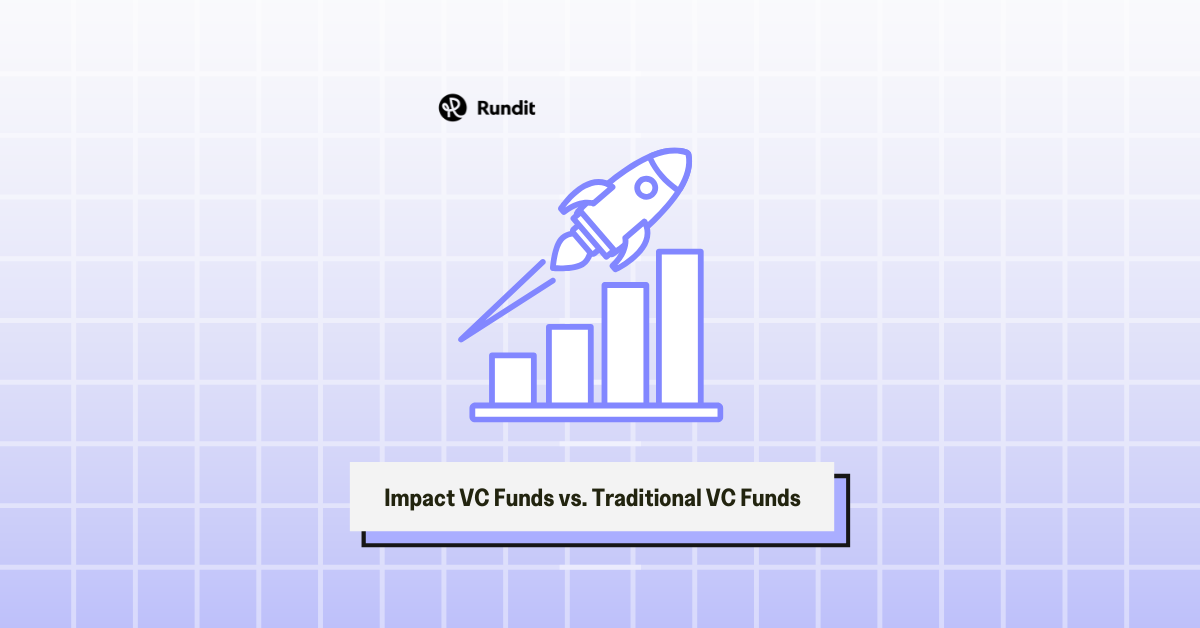Impact Venture Capital (VC) funds and Traditional VC funds both invest in startups, but they differ in their primary goals, investment criteria, return expectations, and approach. Here’s a breakdown of the key differences:
1. Primary Objectives
- Impact VC Funds: Aim to generate both a financial return and measurable social or environmental impact. They focus on investing in companies that solve critical issues like climate change, social inequality, healthcare access, and more.
- Traditional VC Funds: Focus primarily on maximizing financial returns for their investors, often prioritizing high-growth potential startups regardless of their social or environmental impact.
2. Investment Criteria
- Impact VC Funds: Assess companies based on both financial potential and impact potential. They often use frameworks like ESG (Environmental, Social, and Governance) criteria or the UN Sustainable Development Goals (SDGs) to evaluate a company’s potential for positive impact.
- Traditional VC Funds: Prioritize financial metrics such as market size, growth rate, scalability, team capability, and competitive landscape, with little or no formal consideration for social or environmental impact.
3. Return Expectations
- Impact VC Funds: Typically have a “blended” return approach, aiming for competitive financial returns while achieving measurable impact. Some impact funds may accept slightly lower financial returns in exchange for higher social or environmental outcomes.
- Traditional VC Funds: Seek maximum financial returns, often aiming for high multiples (e.g., 10x or more) on their investments, with little concern for social or environmental impact.
4. Investment Approach and Timeline
- Impact VC Funds: Often have a longer-term investment horizon because social or environmental impact initiatives may take more time to mature. They may also provide more patient capital, allowing startups to grow sustainably.
- Traditional VC Funds: Generally have a shorter-term focus, aiming for a quick exit (through an IPO or acquisition) within 5 to 7 years to maximize returns.
5. Stakeholder Engagement and Reporting
- Impact VC Funds: Place a strong emphasis on measuring and reporting impact, often requiring portfolio companies to report on impact metrics regularly. They may also engage more closely with stakeholders such as communities, non-profits, and governments.
- Traditional VC Funds: Focus more on financial metrics like revenue growth, customer acquisition, and profitability. They usually do not require portfolio companies to report on impact metrics.
Subscribe to our newsletter
Sign up to receive our newsletter for exclusive updates, insights, and exciting news delivered straight to your inbox.
6. Types of Companies Funded
- Impact VC Funds: Invest in sectors that align with their impact goals, such as renewable energy, clean technology, affordable healthcare, education technology, social enterprises, and companies focused on inclusivity.
- Traditional VC Funds: Invest across a wide range of sectors, from technology and biotech to consumer goods, with a primary focus on sectors that promise high returns.
7. Fund Structure and Incentives
- Impact VC Funds: May incorporate additional mechanisms such as impact-linked incentives, where fund managers’ compensation is tied not just to financial performance but also to impact achievements.
- Traditional VC Funds: Typically follow a standard VC fund structure, with fund managers compensated mainly through management fees (usually 2% of the fund’s total assets) and a share of the profits (carried interest, often 20%).
8. Investor Base
- Impact VC Funds: Often attract a diverse set of investors who are interested in both financial returns and impact, such as foundations, development finance institutions, high-net-worth individuals, family offices, and certain institutional investors.
- Traditional VC Funds: Attract investors primarily interested in financial returns, including pension funds, insurance companies, endowments, and private wealth managers.
9. Due Diligence Process
- Impact VC Funds: Incorporate impact assessments into their due diligence process, examining how a company’s business model contributes to social or environmental goals and the potential risks associated with negative impacts.
- Traditional VC Funds: Focus on financial due diligence, market analysis, and risk assessment, with limited consideration of impact factors.
10. Exit Strategies
- Impact VC Funds: May look for exit strategies that ensure the continued impact of the portfolio company, such as selling to mission-aligned buyers or using mechanisms like mission protection agreements.
- Traditional VC Funds: Typically focus on exits that maximize financial returns, such as selling to the highest bidder, regardless of the acquirer’s alignment with the startup’s mission.
Conclusion
The distinction between Impact VC and Traditional VC funds highlights the diverse motivations driving investors today. While Traditional VC funds focus on maximizing financial returns, Impact VC funds blend profit with purpose, aiming to create meaningful social and environmental change alongside financial gains. Understanding these differences is crucial for startups and investors alike, as the choice of fund can significantly influence a company’s growth trajectory, stakeholder engagement, and overall impact.
Whether you’re an entrepreneur seeking investment or an investor evaluating your next move, the decision between Impact and Traditional VC funds comes down to aligning your goals, values, and expectations. Both types of funds play vital roles in shaping the future, but the path you choose will determine not just your financial outcomes, but also the broader legacy your investments leave behind.
Looking to enhance your venture capital fund management and reporting?
Rundit offers an advanced platform that simplifies portfolio monitoring and streamlines reporting processes. With Rundit, VC firms can efficiently track portfolio performance, manage investor relations, and gain real-time financial insights—all from one intuitive platform. Our comprehensive dashboards and reporting tools enable you to improve operational efficiency, ensuring you stay focused on what truly matters: making informed investment decisions and driving growth.
Schedule a call with us today to learn more!
Additional resources
Join Rundit
Consolidate your portfolio and fund data in one single report.
